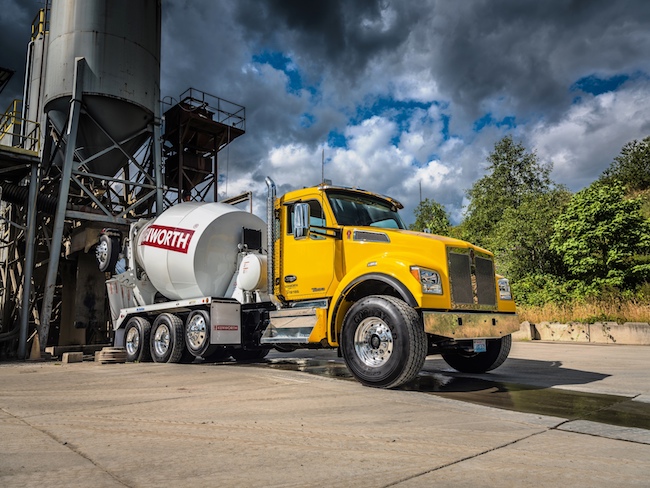
Staying out of the shop: Big data, vocational trucks and the drive toward predictive maintenance
By David Kennedy
Software TrucksUptime matters, particularly when it comes to work trucks. Whether it’s a five-person crew waiting on an aggregate delivery, or an entire job site paralyzed by a concrete mixer stalled in an inopportune spot, delays are always costly.
Until now, carrying out regular preventative maintenance to minimize breakdowns has been about the best construction crews and their suppliers can do when it comes to caring for their vocational vehicles. It’s effective, but it has its limits.
Today, as with all things in construction, advancing technology is leading truck manufacturers in a new direction – one that promises to boost vehicle uptime, bolster productivity and keep materials flowing steadily to and from job sites.
Telematics have become standard on many vocational fleets in recent years, sending an endless stream of fault codes and other performance metrics to OEMs that compile the big data sets to assess things like fleet health and vehicle uptime. As helpful as these figures can be, they’re also stepping stones. Increasingly, truck makers are also employing the data to fuel a shift away from scheduled maintenance and toward forming a more proactive approach to shop time.
“You can’t just collect data without having a plan for something to do with it,” says Roy Horton, director of product strategy at Mack Trucks. “One of the things we’re doing with data is… taking another step forward with predictive maintenance.”
This August, Mack introduced a new dynamic maintenance offering that builds on its GuardDog Connect telematics platform. It also deepened ties with Internet of Things firm Noregon Systems Inc., which it works with on its user interface for dealers. The goal is to leverage vehicle data analytics to replace traditional “set mileage” maintenance with plans that cater to individual fleets or vehicles.
“If you have maintenance that’s required every 30,000 miles, it could be that you could wait for that maintenance further down the road and not have to do it at 30,000 miles,” Horton says.
For the time being, the new offering focuses on powertrain-related maintenance services, but Mack expects to branch out the technology further, making use of the prodigious amount of data it has at its disposal. Currently, there are more than 100,000 trucks equipped with GuardDog Connect.
Other OEMs are following suit.
FROM REACTIVE TO PROACTIVE
Predictive maintenance in the truck market is still in its early stages.
It’s a similar story in other segments of the transportation industry, which are slowly moving from a reactionary approach to maintenance to a proactive one. Rail manufacturers such as Alstom, Bombardier and Siemens for instance, are all embracing a more predictive approach to servicing their trains. Likewise, major elevator makers such as the Otis Elevator Co. and Thyssenkrupp are collecting huge troves of data both to quickly diagnose the specific cause of a breakdown and to take preventative action before a problem occurs.
For work trucks, the ever-evolving telematics platforms offered by the OEMs form the foundation of the shift toward next-generation maintenance.
“Connected vehicles broadcast a variety of data such as engine hours, braking severity, load factor and transmission top gear time that helps fleets understand how vehicles are being operated, identify trends across the fleet and determine which serviceable parts or systems they would like to develop a solution for,” says Jason Krajewski, director of Truck Connectivity for Detroit Connect, the suite of technologies that underpin Detroit engines in Freightliner and Western Star trucks.
Detroit Connect Virtual Technician also steps in when a fault code “event” occurs. It relays information about the fault through email or a notification within an online portal, detailing the severity of the issue, whether the driver is able to resolve the problem and if immediate service is required.
“If the situation is critical, engine data from 60 seconds before and 15 seconds following the fault event is transmitted to the Detroit Customer Support Center (CSC), where experts analyze the data and determine the best resolution,” Krajewski says.
By assessing the telematics data provided through Detroit Connect Virtual Technician, service managers can also pinpoint areas a unit isn’t being run optimally and instruct drivers to make adjustments, he adds.
“Service managers can also look to data to gain insights into service intervals on heavy-duty vehicles,” he says. “For example, they can download a list of faults across their fleet for the last 30 days as well as the fault history for individual vehicles, enabling them to conduct further analysis on fault events occurring on the vehicles.”
Additional intelligence can also help point drivers in the right direction. Kenworth TruckTech+ Remote Diagnostics, for instance, relays real-time engine health information to fleet managers and dealers. When an issue occurs, the system issues a dashboard notification with instructions for operators. Depending on the severity of the problem, drivers can be told to take no action, tackle the issue at the next service interval, head to the closest dealer for service, or pull over immediately to prevent possible damage.
If service is needed, TruckTech+ displays the location of the three closest repair locations on a map. The information can also be forwarded to the servicing dealer, letting them skip the usual diagnostic guessing game. Knowing exactly what’s wrong before a vehicle enters the shop also translates to considerable time savings for technicians who can prepare any parts or tools necessary ahead of time. Of course, this also cuts down on vehicle downtime.
Likewise at Volvo Trucks, telematics are seen as an increasingly key offering – one of the “building blocks” of predictive maintenance. The company’s Remote Diagnostics platform uses a truck-mounted device to transmit data to a central server. Volvo’s web-based ASIST portal handles much of the data, letting owners and drivers monitor truck status, manage repairs and chat directly with their dealer.
“Remote Diagnostics is a cutting-edge, proactive telematics service that monitors powertrain fault codes dynamically and enables the customer to make the right decision based on those codes,” says Ashraf Makki, product marketing manager at Volvo Trucks North America.
Wireless software updates are another promising development, Makki notes.
“Over-the-air software and parameter updates are a big area of focus as we see tremendous potential to maximize uptime for our customers with these technologies,” he says. “Eventually we expect telematics to enable more customization, allowing customers to further optimize their trucks for specific applications.”
THE NEXT STEPS
Foolproof predictive maintenance remains a work in progress, but a time when crews will never have to sit idle waiting for a truck – at least as a result of a breakdown – is no longer science fiction.
“The construction industry is becoming more aware of the telematics capabilities in these vehicles and the value it provides,” says John Felder, product marketing manager for Volvo Trucks North America. “Taking the data we gather from these vehicles and applying it with its operational functions allows us to optimize operations and minimize downtime on job sites.”
One of the tricks will be delivering data to clients in ways they can make use of it.
“Customers are embracing big data to enhance as many facets of their operations as possible,” Krajewski says. “The challenge we face is presenting the data in a consumable manner to reduce the cost of ownership throughout the fleet.”
As in other aspects of construction, the march of vehicle technology will continue to change and improve the way work gets done. There will be more advancements to come as vocational truck OEMs continue their efforts.
“We are continuing to explore and expand the benefits of connected vehicle data,” Krajewski says. “We want to bring useful, informative and actionable insights into all the data being transmitted from our connected vehicles.”
This article first appeared in the October 2019 edition of On-Site. Click here to read through the entire issue.








